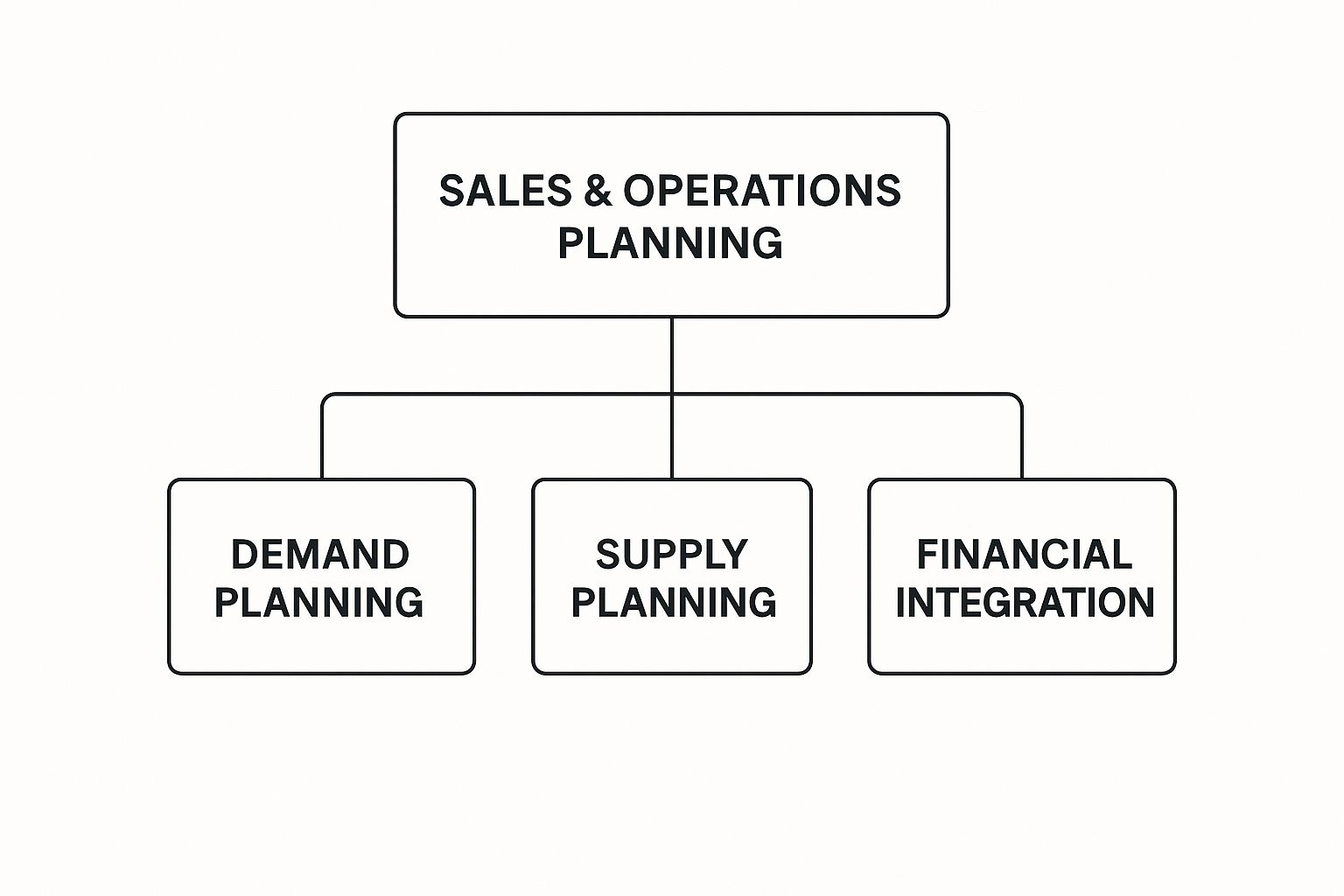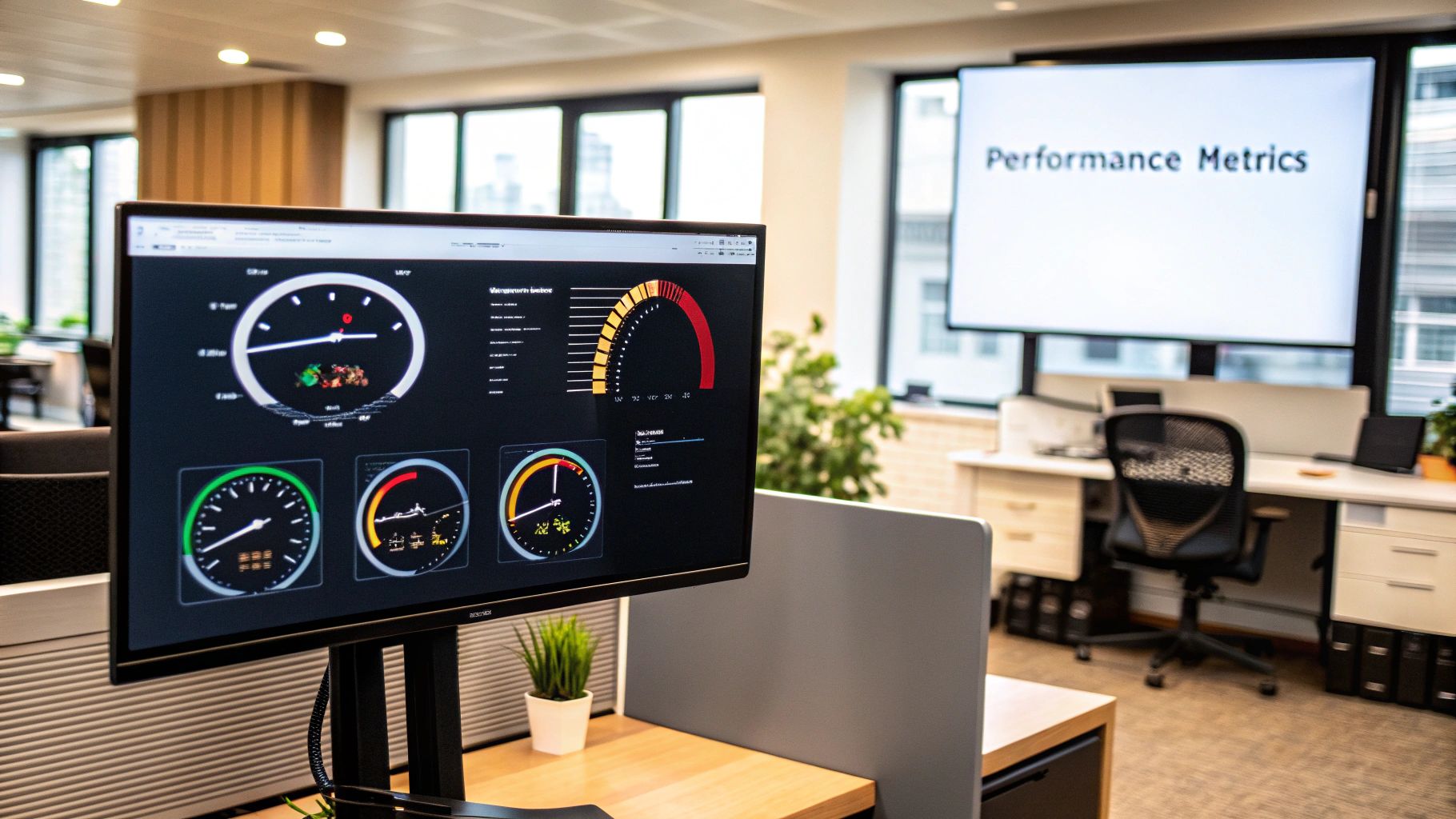Understanding Sales Operations Planning Without the Jargon
Imagine your business is a restaurant. Sales is the waitstaff, taking orders and promising delicious meals. Operations is the kitchen staff, trying to fulfill those orders. Finance is the manager, trying to keep the restaurant profitable. Without sales & operations planning (S&OP), this can be a recipe for disaster.
What if the waitstaff promises a dish the kitchen doesn't have the ingredients for? Or if they overbook the restaurant, leaving the kitchen overwhelmed and customers waiting too long? This is where S&OP comes in.
Think of S&OP as the head chef, coordinating everything. They make sure the menu (sales promises) aligns with the available ingredients and kitchen staff (operational capabilities), all while keeping the budget (financial targets) in mind. This ensures happy customers and a profitable restaurant.
This kind of coordination is especially important in a fast-paced market like California. While statewide S&OP adoption rates aren't always readily available, the growth of related software tells a story. Sales operations grew by 38% from early 2025 to mid-2025—almost five times faster than the overall sales function. Check out this trend here.
Why S&OP Matters More Than Ever
For field sales teams in California, S&OP is like having a local guide. Think about the seasonal ups and downs of tourism or how quickly consumer tastes can change, especially with the influence of the tech industry. S&OP helps field sales teams anticipate these shifts, adjust their strategies on the fly, and stay in close communication with operations and other departments.
Bridging the Gap Between Sales and Operations
S&OP isn't just about planning; it's about building a shared understanding across your business. It breaks down the walls between sales, operations, and finance, creating a common language and shared goals.
This collaborative approach leads to more accurate forecasting, smarter inventory management, and happier customers. By getting everyone on the same page, S&OP helps your team work smarter, not harder.
The result? A more efficient, profitable, and resilient business. S&OP sets the stage for informed decisions and proactive problem-solving, essential for success in California's competitive market.
The Five Essential Pillars That Make S&OP Actually Work
Building effective sales & operations planning (S&OP) isn't about shiny new software. It's about creating a solid foundation, much like building a house. Imagine five essential pillars holding up your S&OP house: demand planning, supply planning, integrated business planning, performance measurement, and organizational alignment. A crack in any one of these pillars could jeopardize the entire structure.
Demand and Supply: Knowing What You Want and Getting What You Need
Let's start with the first two pillars. Demand planning is like understanding what your friends actually want for their birthday, not just what you think they want. It’s about accurate forecasting based on real data, not wishful thinking. This leads directly to supply planning, which ensures you can deliver those birthday gifts without breaking the bank. Think of a California business anticipating the summer tourism rush or a tech company predicting the demand for its newest gadget. Both need solid demand and supply planning.
Then there's integrated business planning, the glue that holds everything together. This is like making sure everyone involved in the birthday party – the party planners, the caterers, the entertainers – are all on the same page, working towards a shared vision of a successful celebration.

This infographic shows how demand planning, supply planning, and financial integration all connect within the central S&OP process. Notice how financial planning plays a vital role alongside demand and supply considerations. They’re all interconnected pieces of the S&OP puzzle.
Measuring Success and Aligning Your Team
So, how do you know if your S&OP party is a hit? That’s where performance measurement comes in. It’s like checking in with your party guests – are they having fun? Is the food good? In S&OP, this translates to tracking key metrics, like forecast accuracy and inventory turnover. It's not just about sales numbers, but understanding why those numbers are what they are. This helps you spot potential problems and make adjustments.
Finally, we have organizational alignment. This is like ensuring everyone involved in the party – from the hosts to the guests – understands the purpose of the celebration and is excited to participate. In a business context, this might involve training your team on S&OP principles or setting up clear communication channels. You might find resources like this guide on lead routing best practices helpful for improving communication within your sales team. This alignment makes your entire S&OP system stronger than its individual parts.
To illustrate the key differences and potential pitfalls within each of these pillars, let's examine them more closely. The following table breaks down each pillar's core function, common implementation challenges, and signs of success.
S&OP Pillar Comparison: Strengths and Common Challenges
table block not supported
As you can see, implementing a robust S&OP process requires careful consideration of each pillar. By addressing potential challenges head-on and focusing on the success indicators, you can create a system that truly drives growth and profitability for your business. By focusing on these five pillars, you can build a rock-solid S&OP process that helps your California business thrive.
Assembling Your S&OP Dream Team (Politics and All)

Building a successful Sales & Operations Planning (S&OP) team isn't about recruiting superstars. It's about finding the right mix of people who can collaborate effectively. Think of it like building a basketball team: you need a point guard to direct the flow, a center to dominate the paint, and a solid bench to provide support. In S&OP, you need sales folks who understand operational constraints, operations experts who grasp market realities, and finance professionals who can connect the dots.
Identifying Key Players: More Than Just Job Titles
Your ideal S&OP team should include members from every core business function. This might include a Demand Planner to analyze market trends, a Supply Planner to manage logistics, and a Financial Analyst to track performance.
But job titles only tell part of the story. Sometimes the most valuable input comes from unexpected sources. A seasoned sales rep in CA might have a better understanding of local market nuances than a national marketing manager, for example.
Finding people with the right mindset is key. Look for individuals who are collaborative, data-driven, and comfortable with adapting to change. They need to see the bigger picture and work together towards a shared goal.
Navigating Office Politics: The Art of Buy-In
Let’s face it, internal politics are a reality in any organization. Even with a great team, getting buy-in from skeptical stakeholders can be tough. Clear communication and tangible results are your best tools.
Start by explaining the advantages of S&OP, focusing on how it solves specific problems within the company. If excess inventory is a constant headache, emphasize how S&OP can improve forecasting accuracy and reduce carrying costs.
Creating an environment of open communication is also crucial. Team members need to feel safe sharing their thoughts and challenging assumptions without fear of negativity. This leads to better decisions, even when the choices are difficult.
Creating a Collaborative Culture: From Dread to Excitement
The best S&OP teams don’t just attend meetings; they actively participate and look forward to them. These meetings become a space for productive problem-solving and strategic planning.
By fostering a collaborative environment where everyone’s contribution is valued, you create a team that is not only effective but also engaged. This positive energy is infectious and reinforces the importance of S&OP throughout the company.
Remember, it's not about finding perfect individuals. It's about creating a supportive environment where talented people can thrive together. Consider using tools like LeadFlow Manager to improve communication and teamwork, especially for field sales teams. You can learn more about its applications for door-to-door sales here. Building a strong S&OP team requires investment, but the payoff is significant. Focus on the right people, encourage open communication, and cultivate a collaborative culture, and you'll build a team that can effectively navigate the complexities of any market and drive real business results.
Your Monthly Business Health Check: The S&OP Rhythm
Think of Sales & Operations Planning (S&OP) as your company's monthly checkup. Just like visiting the doctor keeps you healthy, a regular S&OP process keeps your business running smoothly and helps you respond to market changes. It’s not about bureaucracy, it's about building a healthy business.
Structuring Your S&OP Cycle: From Optimism to Action
Effective S&OP isn't a one-off event, but a continuous cycle throughout the month. Imagine a typical four-week cycle like this:
- Week 1: Data Gathering. This is the optimistic phase. Sales teams project their potential wins, and you collect market data. Everyone’s excited about the possibilities.
- Week 2: Demand & Supply Review. Now, reality sets in. Operations analyzes whether those sales projections are actually doable with your current resources and capacity. This is where the real conversations start.
- Week 3: Reconciliation & Collaboration. Sales and operations teams work together to balance ambitious goals with what's realistically achievable. They find potential roadblocks and brainstorm solutions. Think scenario planning: "What if we increase production?" or "What if we offer incentives to shift demand?"
- Week 4: Executive S&OP Meeting & Decision Making. This is where the plan takes shape. Executives review the reconciled plan, make key decisions about resources, and approve the final operational strategy.
Running Effective S&OP Meetings: Solving Problems, Not Dwelling on the Past
S&OP meetings shouldn't be about dissecting last month's failures. They should focus on looking ahead, solving problems, and making decisions. A key to success is having clear decision-making frameworks. For example, if demand outstrips supply, a pre-agreed framework could prioritize certain customer segments.
This proactive planning is particularly important for businesses in California, where market conditions can change quickly. Consider the impact of seasonal tourism on hospitality or the volatility of the tech industry on supply chains. A solid S&OP process helps companies adapt and succeed in these challenging environments. For example, California's taxable sales growth offers insights for sales planning. According to the state's 2025-26 budget, taxable sales growth in 2024-25 and 2025-26 is projected at about 3% annually, suggesting a return to pre-pandemic patterns. Discover more insights here.
Making Confident Decisions in Uncertain Times
Even with good data, uncertainty is a fact of life. Supply chains can break down, customer preferences can shift overnight, and markets can fluctuate. S&OP gives you a framework for making confident decisions even when you don't have all the information. By using scenario planning and establishing clear decision-making protocols, businesses can respond quickly and effectively to unexpected issues. Check out our guide on getting started with LeadFlow Manager for tools that can improve communication and data gathering for your S&OP process.
A strong S&OP process becomes as crucial as your monthly financial close—a vital routine for maintaining a healthy business and ensuring long-term success. It empowers companies to not just react to market changes, but to anticipate them, adapt to them, and even use them to their advantage. This proactive approach is what sets successful companies apart in today's complex business world.
Turning Market Chaos Into Competitive Advantage

Think of a surfer confidently riding a massive wave. While others might panic, experienced surfers see these moments as opportunities. In the same way, businesses with strong sales & operations planning (S&OP) processes thrive in uncertain markets. They don't just weather the storm; they find ways to come out stronger. This section explores how S&OP acts as both an early warning system and a quick response team, turning market unpredictability into a competitive edge.
Scenario Planning: Preparing for Multiple Futures
Imagine a California vineyard owner preparing for the growing season. The weather is unpredictable, so they create plans for various possibilities: ideal sunshine, moderate rain, and even a late frost. Each scenario calls for different actions, impacting everything from irrigation strategies to when they harvest the grapes.
S&OP teams use a similar approach. By developing plans for different market scenarios – like a sudden spike in demand or a disruption from a key supplier – businesses can respond quickly and effectively when the unexpected occurs. This proactive planning helps avoid rash decisions and maintains team stability during challenging times. Think of a tech company in Silicon Valley anticipating both a boom and a bust scenario for their new product launch.
Responding to Change: Balancing Speed and Accuracy
When market conditions change quickly, fast decision-making is critical. However, speed shouldn't compromise accuracy. Think of a wildfire response team. They need to act quickly, but also make informed choices based on the most accurate information available.
A solid S&OP process provides the structure for this balanced approach. It creates better visibility across the organization, making it easier to identify potential issues early on and evaluate different solutions. California's automotive sector, for instance, is particularly dynamic with the expanding zero-emission vehicle (ZEV) market. In the first quarter of 2025, Californians purchased 100,326 ZEVs, about 23% of all new vehicle sales statewide. This fast-paced environment makes robust S&OP essential. Discover more insights about California's ZEV market here. This data highlights the importance of flexible planning in a rapidly changing market.
Reducing Risk Through Enhanced Visibility
Strong S&OP processes don't increase risk; they reduce it. By providing a clear view of your entire operation, S&OP helps you make more informed choices when the unexpected inevitably happens. For example, if supply chain disruptions occur, a well-defined S&OP process enables you to quickly identify alternative suppliers, adjust production schedules, or even shift inventory to prioritize key customers.
Consider a California manufacturer suddenly facing a surge in demand. A well-executed S&OP process allows them to evaluate production capacity, assess current inventory, and make informed decisions about whether to increase production, speed up shipments, or even temporarily change pricing. This agility, built on a strong S&OP foundation, gives companies a significant advantage over their less-prepared competitors.
From Reaction to Proaction: Embracing Uncertainty
Instead of fearing market volatility, companies with mature S&OP processes see uncertainty as an opportunity. They view it as a chance to gain market share and strengthen their overall position. By developing plans for multiple scenarios, balancing speed with accuracy in their decision-making, and creating better visibility across their organization, these companies move from simply reacting to proactively shaping their future. This proactive mindset becomes a key strength, allowing businesses to not just survive market chaos, but thrive in it.
Measuring What Actually Matters in S&OP Performance
Imagine evaluating a hockey team's performance. You wouldn't simply focus on the number of goals scored, right? You'd also consider assists, power-play success, and even the team's overall morale. Similarly, measuring the effectiveness of your sales & operations planning (S&OP) process requires looking beyond just sales figures and delving into the overall health of your business operations.
Beyond the Obvious: Metrics That Truly Matter
Metrics like forecast accuracy and inventory turns are important, much like tracking goals scored. They offer valuable insights, but they don't tell the whole story. We also need to consider metrics like decision-making speed, reflecting how quickly your team adapts to market shifts, and cross-functional trust levels, which reveal the effectiveness of collaboration between different departments.
Think of a California produce distributor facing an unexpected heatwave. Their ability to swiftly adjust their supply chain to mitigate spoilage – perhaps by rerouting shipments or boosting refrigeration capacity – is a more accurate indicator of S&OP effectiveness than simply monitoring initial sales projections.
Building Dashboards That Tell the Real Story
Effective S&OP dashboards should differentiate between lagging indicators (what has already occurred) and leading indicators (what is likely to occur). Lagging indicators are like your rearview mirror – helpful for understanding the past, but not for navigating the road ahead. Leading indicators, on the other hand, act like your GPS, helping you anticipate upcoming challenges and adjust your course accordingly.
A well-designed dashboard should track both hard numbers (like cost savings and on-time delivery rates) and soft outcomes (such as team morale and cross-functional communication). For a field sales team in California, this might involve metrics like lead response time and customer satisfaction.
Setting Benchmarks: Motivation Without Manipulation
Setting realistic benchmarks is essential. The goal is to encourage improvement without setting unattainable expectations. It's like training for a marathon – you wouldn't attempt to run 26 miles on your first day. Instead, you'd establish achievable milestones along the way.
Avoid the temptation to manipulate metrics for a superficial appearance of success. Focus on genuine progress, not artificially inflated numbers.
Continuous Improvement: Evolving Your S&OP Process
The true value of S&OP metrics lies not just in reporting, but in learning and adapting. Use your performance data to continuously refine your S&OP process. Think of it as a feedback loop: analyze what's working, identify areas for improvement, and adjust your strategy accordingly. This iterative process ensures your S&OP process remains a dynamic tool for growth, not just a static monthly report.
To help you construct a more effective S&OP dashboard, let's examine the following table:
Essential S&OP Metrics: Leading vs. Lagging Indicators
table block not supported
This table provides a starting point for building your own customized dashboard. Remember, the specific metrics you choose will depend on your industry, business goals, and specific circumstances.
By embracing these principles and adopting a data-driven approach, you can transform your S&OP process into a powerful engine for growth and profitability. This is particularly crucial for businesses operating in California's competitive landscape, where agile decision-making and adaptability are essential for success.
Your S&OP Journey: From Chaos to Clarity

Starting your Sales & Operations Planning (S&OP) journey isn't about flipping your entire business upside down. It's about taking a good, honest look at where you are today and plotting a course forward. This guide offers practical advice for businesses in the CA region, whether you're building your S&OP process from the ground up or reviving one that's stalled out.
Assessing Your Planning Maturity: Finding Your Starting Point
Think of it like planning a road trip. You wouldn't hit the gas without knowing where you are and where you want to go. Figuring out your S&OP maturity works the same way. It means understanding your current planning processes, spotting any gaps, and setting realistic goals for improvement.
Don't get discouraged by the gaps. Look for those "quick win" opportunities instead. For example, if your demand planning feels like throwing darts in the dark, a simple improvement could be incorporating historical sales data. This small step offers a more accurate baseline for future forecasts.
Quick Wins: Building Momentum and Credibility
Early successes are essential for building momentum and getting your team on board. Focus on manageable improvements with visible results.
Imagine a California vineyard implementing S&OP. Rather than a complete system overhaul, they might start by simply improving communication between the vineyard manager and the sales team regarding upcoming harvests. This seemingly small change can greatly improve inventory management and customer satisfaction.
These quick wins breed confidence and prove the value of S&OP.
Long-Term Improvements: Sequencing for Maximum Impact
After those initial victories, you can start tackling the more complex improvements. But it's crucial to approach these strategically, considering your resources and priorities.
For example, after improving communication, the vineyard might invest in a software solution like ClimeCell to track weather patterns and predict grape yields. This allows for more proactive planning and minimizes the effect of unexpected weather.
